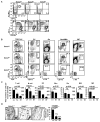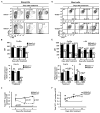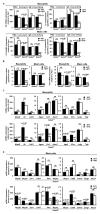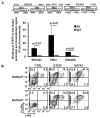The STAT5-GATA2 pathway is critical in basophil and mast cell differentiation and maintenance
- PMID: 25801432
- PMCID: PMC4405376
- DOI: 10.4049/jimmunol.1500018
The STAT5-GATA2 pathway is critical in basophil and mast cell differentiation and maintenance
Abstract
Transcription factor GATA binding protein 2 (GATA2) plays critical roles in hematopoietic stem cell survival and proliferation, granulocyte-monocyte progenitor differentiation, and basophil and mast cell differentiation. However, precise roles of GATA2 in basophil and mast cell differentiation and maintenance have not been delineated. We have identified GATA2 as an essential transcription factor in differentiation of newly identified common basophil and mast cell progenitors into basophils and mast cells. We observed Gata2 haploinsufficiency for mast cell differentiation, but not for basophil differentiation. We examined the precise role of GATA2 in maintaining the expression of a wide range of genes that are important for performing basophil or mast cell functions. The effects of GATA2 on gene expression were broadly based. We demonstrated that GATA2 was required for maintaining Fcer1a mRNA and FcεRIα protein expression on both basophils and mast cells, as well as for maintaining Kit mRNA and c-Kit protein expression on mast cells. GATA2 was required for histamine synthesis and was also critical for Il4 mRNA expression in basophils and Il13 mRNA expression in mast cells. We demonstrate a STAT5-GATA2 connection, showing that the STAT5 transcription factor directly bound to the promoter and an intronic region of the Gata2 gene. Overexpression of the Gata2 gene was sufficient to direct basophil and mast cell differentiation in the absence of the Stat5 gene. Our study reveals that the STAT5-GATA2 pathway is critical for basophil and mast cell differentiation and maintenance.
Copyright © 2015 by The American Association of Immunologists, Inc.
Conflict of interest statement
The authors have no financial conflicts of interest.
Figures






Similar articles
-
Critical Roles for PU.1, GATA1, and GATA2 in the expression of human FcεRI on mast cells: PU.1 and GATA1 transactivate FCER1A, and GATA2 transactivates FCER1A and MS4A2.J Immunol. 2014 Apr 15;192(8):3936-46. doi: 10.4049/jimmunol.1302366. Epub 2014 Mar 17. J Immunol. 2014. PMID: 24639354
-
Transcription factor IRF8 plays a critical role in the development of murine basophils and mast cells.Blood. 2015 Jan 8;125(2):358-69. doi: 10.1182/blood-2014-02-557983. Epub 2014 Nov 14. Blood. 2015. PMID: 25398936 Free PMC article.
-
Regulation of basophil and mast cell development by transcription factors.Allergol Int. 2016 Apr;65(2):127-134. doi: 10.1016/j.alit.2016.01.006. Epub 2016 Mar 10. Allergol Int. 2016. PMID: 26972050 Review.
-
The Transcription Factor Ehf Is Involved in TGF-β-Induced Suppression of FcεRI and c-Kit Expression and FcεRI-Mediated Activation in Mast Cells.J Immunol. 2015 Oct 1;195(7):3427-35. doi: 10.4049/jimmunol.1402856. Epub 2015 Aug 21. J Immunol. 2015. PMID: 26297757
-
Transcriptional regulation of mast cell and basophil lineage commitment.Semin Immunopathol. 2016 Sep;38(5):539-48. doi: 10.1007/s00281-016-0562-4. Epub 2016 Apr 28. Semin Immunopathol. 2016. PMID: 27126100 Free PMC article. Review.
Cited by
-
IL-3 Expands Pre-Basophil and Mast Cell Progenitors by Upregulating the IL-3 Receptor Expression.Cell Immunol. 2022 Apr;374:104498. doi: 10.1016/j.cellimm.2022.104498. Epub 2022 Mar 6. Cell Immunol. 2022. PMID: 35334276 Free PMC article.
-
Heterozygous variants in GATA2 contribute to DCML deficiency in mice by disrupting tandem protein binding.Commun Biol. 2022 Apr 19;5(1):376. doi: 10.1038/s42003-022-03316-w. Commun Biol. 2022. PMID: 35440757 Free PMC article.
-
Novel insights into the ontogeny of basophils.Front Allergy. 2024 May 13;5:1402841. doi: 10.3389/falgy.2024.1402841. eCollection 2024. Front Allergy. 2024. PMID: 38803659 Free PMC article. Review.
-
A Co-Expressed Natural Antisense RNA FCER1A-AS Controls IgE-Dependent Immunity by Promoting Expression of FcεRIα.Microbiol Spectr. 2023 Jun 15;11(3):e0073323. doi: 10.1128/spectrum.00733-23. Epub 2023 May 8. Microbiol Spectr. 2023. PMID: 37154775 Free PMC article.
-
Epigenetic and transcriptional control of mast cell responses.F1000Res. 2017 Nov 29;6:2064. doi: 10.12688/f1000research.12384.1. eCollection 2017. F1000Res. 2017. PMID: 29225792 Free PMC article. Review.
References
-
- Galli SJ, Kalesnikoff J, Grimbaldeston MA, Piliponsky AM, Williams CM, Tsai M. Mast cells as “tunable” effector and immunoregulatory cells: recent advances. Annu Rev Immunol. 2005;23:749–786. - PubMed
-
- Karasuyama H, Mukai K, Obata K, Tsujimura Y, Wada T. Nonredundant roles of basophils in immunity. Annu Rev Immunol. 2011;29:45–69. - PubMed
Publication types
MeSH terms
Substances
Grants and funding
LinkOut - more resources
Full Text Sources
Other Literature Sources
Molecular Biology Databases
Miscellaneous

